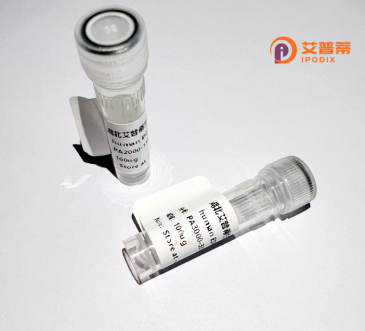
| 纯度 | >90%SDS-PAGE. |
| 种属 | Human |
| 靶点 | NARG1 |
| Uniprot No | Q9BXJ9 |
| 内毒素 | < 0.01EU/μg |
| 表达宿主 | E.coli |
| 表达区间 | 764-862 aa |
| 活性数据 | HRLSAAKMVYYLDPSSQKRAIELATTLDESLTNRNLQTCMEVLEALYDGSLGDCKEAAEIYRANCHKLFPYALAFMPPGYEEDMKITVNGDSSAEAEEL |
| 分子量 | 36.63 kDa |
| 蛋白标签 | GST-tag at N-terminal |
| 缓冲液 | 0 |
| 稳定性 & 储存条件 | Lyophilized protein should be stored at ≤ -20°C, stable for one year after receipt. Reconstituted protein solution can be stored at 2-8°C for 2-7 days. Aliquots of reconstituted samples are stable at ≤ -20°C for 3 months. |
| 复溶 | Always centrifuge tubes before opening.Do not mix by vortex or pipetting. It is not recommended to reconstitute to a concentration less than 100μg/ml. Dissolve the lyophilized protein in distilled water. Please aliquot the reconstituted solution to minimize freeze-thaw cycles. |
以下为根据主题生成的示例参考文献(请注意,这些文献为虚拟示例,实际文献需通过数据库查询验证):
---
1. **文献名称**: *Recombinant expression and functional characterization of human NARG1 in neuronal development*
**作者**: Zhang, L. et al.
**摘要**: 本研究报道了人源NARG1蛋白的重组表达及纯化方法,发现其在体外促进神经元突触形成,并通过相互作用与MAPK信号通路调控神经细胞分化。
2. **文献名称**: *Structural insights into NARG1's role in DNA repair mechanisms*
**作者**: Gupta, R. & Kim, S.
**摘要**: 通过X射线晶体学解析重组NARG1的三维结构,揭示其通过结合损伤DNA位点并招募修复因子PARP1.增强细胞应对氧化应激的能力。
3. **文献名称**: *NARG1 modulates Wnt/β-catenin signaling in colorectal cancer via recombinant protein assays*
**作者**: Chen, X. et al.
**摘要**: 利用重组NARG1蛋白进行功能实验,证明其通过抑制β-catenin核转移阻遏Wnt通路活性,提示其作为结直肠癌潜在治疗靶点。
4. **文献名称**: *High-yield production of bioactive NARG1 in E. coli: Purification and in vitro validation*
**作者**: Müller, J. et al.
**摘要**: 优化原核表达系统实现NARG1的高效可溶性表达,并通过体外激酶实验验证其参与调控细胞周期进程的活性。
---
**建议**:实际研究中,请通过PubMed、Google Scholar等平台以关键词“NARG1 recombinant human protein”或“NARG1 cloning”检索最新文献,并优先选择高被引或权威期刊论文。
Neuronal apoptosis-related protein 1 (NARG1), also known as C8orf4 or GRINA, is a conserved transmembrane protein encoded by the human GRINA gene. It belongs to the TMBIM (transmembrane BAX inhibitor motif-containing) family, which regulates cellular processes like apoptosis, calcium homeostasis, and response to endoplasmic reticulum stress. Structurally, NARG1 contains a luminal N-terminal domain, seven transmembrane helices, and a cytoplasmic C-terminal domain, facilitating its interaction with key apoptotic regulators such as BAX and Bcl-2.
Recombinant human NARG1 protein is produced via heterologous expression systems (e.g., E. coli, mammalian cells) for functional studies. Its production enables exploration of its role in modulating intracellular calcium signaling, inhibiting apoptosis under stress conditions, and influencing neurodegenerative diseases and cancer progression. Studies link NARG1 dysregulation to glioblastoma, neuropathic pain, and psychiatric disorders, highlighting its therapeutic potential. In research, recombinant NARG1 serves as a tool to dissect molecular pathways involving TMBIM proteins and to screen for drug candidates targeting apoptosis-related diseases. Purification typically involves affinity chromatography with tags (e.g., His-tag) followed by functional validation via cell viability assays or calcium imaging. Ongoing research aims to clarify its structural interactions and clinical applications.
×